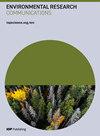Estimating construction waste in New Zealand: a focus on urban areas, residential and non-residential building activities
IF 2.9
4区 环境科学与生态学
Q3 ENVIRONMENTAL SCIENCES
引用次数: 0
Abstract
This paper examines the significant increase in construction waste (CW) due to urbanisation and population growth in New Zealand and worldwide. The aim is to estimate CW using available data in New Zealand and identify relevant indicators to employ estimation methods. Various methods and models for estimating CW at the urban level and from building activities are reviewed. According to the best available data, the paper uses the per-capita multiplier and waste generation rate methods to estimate CW in New Zealand. New Zealand’s per-capita multiplier for CW is 943.46 kg/per capita. The waste generation method using the floor area indicator is applied at residential and non-residential building levels. The estimated CW in 2021 was 531,109 tonnes for residential and non-residential buildings using the floor area indicator. The findings reveal a positive relationship between residential building activity and population growth, with Auckland generating the highest rate of CW. Because of the limitations of the available data and estimation methods, the paper highlights the need for standardised data collection systems and outreach programs to improve CW estimation practices. Further research is recommended to enhance waste reduction strategies and identify high-waste-generating materials and methods. It is vital to have accurate CW estimations to support project waste management plans and sustainable construction practices and to inform waste management policies and regulations at the regional or national level.估算新西兰的建筑垃圾:重点关注城市地区、住宅和非住宅建筑活动
本文探讨了新西兰和世界范围内由于城市化和人口增长而导致的建筑垃圾(CW)的大幅增加。目的是利用新西兰的现有数据估算建筑垃圾,并确定采用估算方法的相关指标。研究回顾了估算城市和建筑活动产生的建筑垃圾的各种方法和模型。根据现有的最佳数据,本文采用人均乘数和废物产生率方法来估算新西兰的化学武器。新西兰的人均化武乘数为 943.46 千克/人均。使用建筑面积指标的废物产生方法适用于住宅和非住宅建筑层面。使用建筑面积指标估算的 2021 年住宅和非住宅建筑的化石燃料为 531 109 吨。研究结果表明,住宅建筑活动与人口增长之间存在正相关关系,其中奥克兰的化石排放量最高。由于现有数据和估算方法的局限性,本文强调了标准化数据收集系统和推广计划的必要性,以改进化石燃料估算方法。建议开展进一步研究,以加强减少废物的策略,并确定高废物产生量的材料和方法。准确的化石燃料估算对于支持项目废物管理计划和可持续建筑实践,以及为地区或国家层面的废物管理政策和法规提供信息至关重要。
本文章由计算机程序翻译,如有差异,请以英文原文为准。
求助全文
约1分钟内获得全文
求助全文

 求助内容:
求助内容: 应助结果提醒方式:
应助结果提醒方式:


